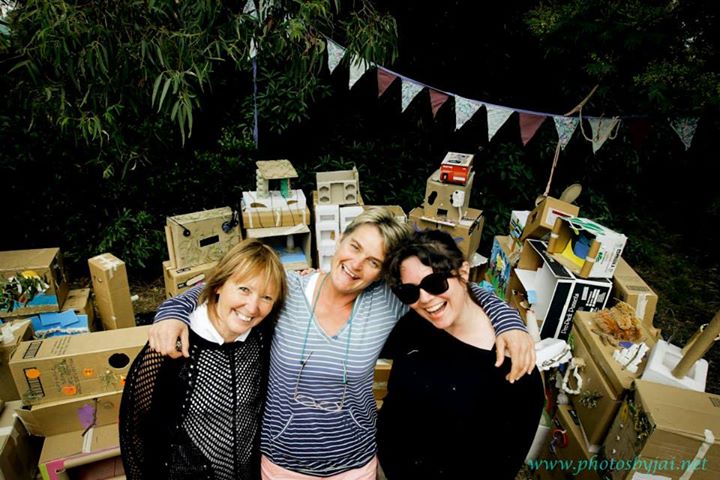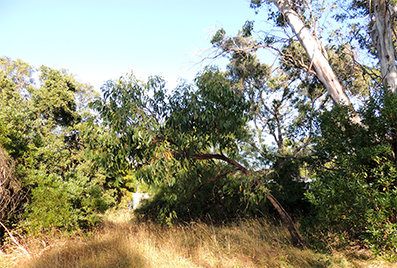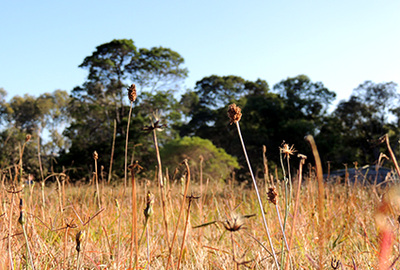|
This beautiful piece was created as part of a larger installation at Selandra Community Centre, sponsored by Casey Shire Recycling and Waste Landfill Management Team. Super progressive shire supporting local makers and creators (their beautiful Gallery at Bunjil place is well worth a visit. The weaving was created over several sessions from single use plastics and various found materials with the Selanda Community in September 2018.
0 Comments
Along with the Wall collection we installed the final cubby construction from the grade 5-6 students. Being outside on the land, there was much finger crossing and forecast checking for the weather. Wind could be the project's downfall (literally), and with projected breezes from the south west i decided to play safe and put the installation in sheltered spot in the shade of a large acacia. It had a cubby kind of feel, and with the ground underneath relatively flat - we had a good base to lay boards for overall stability. In case of emergencies, I had a kit of ropes with tent pegs, tarps and posts, spay adhesive, and adhesive tape to make sure the whole thing didn't blow away. The plan was to bring along the boxes, and allow the kids to build their own cubby in an interactive art display. Here's what happened... Throughout the day, several different configurations emerged... with the students enjoying finding their own construction then placing it in the perfect spot. Kids who weren't involved in the workshops were also keen to be involved, which was great. I had hoped that more of the students would take their mini cubbies home once the garden festival had finished, but at the end of the day pretty much all of the boxes remained. So, with the help of a (mostly willing) team of volunteers we carried the boxes across the land and back to school for the students to pick up from there. The above photos are thanks to the incredibly talented Jai Seales who captured the day beautifully here.
Inspiration for the construction component for grade prep - 2's came from the artist Louise Nevelson. Not only was her story interesting; a woman artist working at a time when art was considered a masculine domain but her methodology was readily transferable to working with the younger grades. Each student would be able to achieve a finished sculptural piece, and together the works would combine to create a cohesive piece with (hopefully) plenty of visual impact. I introduced the classes to Nevelson, explaining that she grew up playing in her fathers' timber yard and making things (much like they had in previous art classes) with scraps of timber. We looked at images of her works and the way she combined interesting shapes to create her sculptures, then talked about her inspiration... nature, the city and space. Our next step was to combine the layered relief sculptures we had created during the last session with salvaged commercial materials into shoe boxes. The students were asked to use each interior surface of the box as a base (sides as well as base). The results were really impressive, with everyone achieving an interesting result. While I'd initially planned on spay painting each box the same colour, to replicate the style of Nevelson's sculptures, an unsuccessful grant application meant that the funding wasnt available. On refection -I think the kids will prefer seeing their work as they completed it anyway. So I'm happy with that.
Some students did extend the assemblage beyond the initial single lesson, so we were lucky to have an optional additional session to complete the project. My initial inspiration for “Growing Home" came from the RIVER QUIVER project from Turpin and Crawford; a community art project that emerged from explorations into a specific environment. In this case the Pages River and the NSW town of Murrundi. The video is well worth a watch if you're interested in environmental art. Subsequent research then, was based around the construction of large scale “puppets” that could be installed temporarily on the land in Balnarring. As I began to gather ideas and reconcile resources and restrictions on time and space, it became clear that a project the scale of River Quiver wasn't going to be achievable. So I began considering what the essential themes of the project were - and use those themes as a starting point for the workshops.
Hence Growing Home. Exploring what ideas of what HOME means to us. How do we create our homes? What elements of ourselves go into that creative process? The work of German artist Friedenreich Hundertwasser provided a great place to start. Not only could we link our warm up drawing exercises using spirals to his art, but his concept of skins was a useful way to introduce the grade 5-6’s into thinking about the ways we express ourselves though the environments we create. Briefly, the idea we talked about was that one way to understand ourselves and our place in the world is through our skins: epidermis, clothes, home, social environment and the earth. By asking the students to include elements representing themselves in the design of their own personal environments or cubby constructions, we aimed to extend understanding of their creative process in the building their own worlds. And its a bit of a leap... but extending that experience as a metaphor for life. PHEW. Art and Philosophy - nailed it. With the beginning of the construction component of our project, once again my main concern (particularly as these were the least structured lessons) was that the kids would whack together some cardboard and plastic in a box then call it done. 10 minutes tops. And its true - some of the younger grades did tend to rush, but over all the process took much longer than I'd feared. phew. With the preps - grade 2's I decided to break down the lesson further. I'd determined that our first learning goal would be an exploration of space and size in composition. Attempting to explain space to the preps really got me thinking. I'd never considered what abstract concept it is. The best explanation we (as a group) came up with was in space in relation to another object - ie this table is next to that chair, there is empty space between that we call negative space. The space the table takes up, is positive space. Then we made some drawings. Using shapes, we started filing the negative space on a page. We noticed that we needed to draw progressively smaller shapes to really fill the page. Next - we introduced the concept of dimension. We began making a relief sculpture, building up the surface using layered shapes on cardboard. Some kids were happy to work using simple geometric or organic forms while others were keen to work figuratively. These sculptural elements were to be included into the shoe box assemblage to be introduced in the next session. Gorgeous.
The thing I've been spending most time on lately as far as the project goes is getting together a management plan. Identifying timelines, objectives, priorities, frameworks, constraints, resources and stakeholders. Documentation. Aaaaaaaaaahhhhhhh.
While that stuff is dry and dare I say it - a little boring, at least its doing something. The hard bit has been coming up with a concept for the workshops to fit into the constraints... Those being:
Ive been considering the possibility of working with the theme of "GROWING HOME" - thinking that the characteristics of cardboard may lend itself to some architectural style assemblages or structures. The thinking is that there is enough scope for the diverse age groups to achieve some thought provoking results while still keeping a cohesive aesthetic. Ive been doing a little research and found some great resources here and here for kids sculptural projects that have provided some great inspiration. A great place to gather materials is reverse art truck - And today I've had some fun playing with a Louise Nevelson style assemblage that could be a good way to go with the younger kids, if I can just solve the problem of suitable adhesives (ideas gratefully received). So... Calling this thing "the public art project" is getting tired. I need something new, zappy, inspired and inspiring. Something that captures the imagination yet creates the desire for wanting to know more... a little mystery maybe. And I need your help.
Bear in mind that the project will be: *family friendly *use recycled, waste or natural materials *will be temporarily installed in OCTOBER 2014 *based on designs inspired by indigenous flora and fauna Post your comments here with your thoughts for what to call this thing and there may well be a prize of some description ( my eternal thanks, or even a painting) to those that I REALLY like. THE IDEA: to create a project that brings together awesome things. Art, community and a thriving environment.
It all started a few years ago with a few friends sitting around imagining how cool it would be to have a community garden. A place to share stories, veggies, experience, and ideas... We realised that the perfect parcel of land was almost under our feet and so went about developing a concept that could be presented to the community. We did, they liked the idea and the concept grew (like a little seedling). Today Balnarring Village Common is working to create a space for the whole community to meet, interact and grow together. As it turns out, securing unused public land for community activity has been a task a little like walking el camino. Its a reeeaaalllly long road. Its just as well nice things happen along the way. Anyhoo. Where does the Art fit ? I hear you ask. Basically - in order to get people to notice, interact and dare I say it ... get passionate about the parcel of land in their front yard that is likely to turn into at best, yet another block of shops selling stuff that is oh so desirable but not at all necessary to our health and happiness if we don't raise our collective hands and say "hold on just a second there cowboy", I'll be implementing a temporary sculptural installation in association with the folks at Balnarring Primary School on 3051-3053 Frankston Flinders Rd Balnarring. The installation is planned for October 2014, with workshops through July, August and September. I'll be documenting the whole process here. If you'd like to be a part of the whole sh'bang... be sure to leave me a comment. Meanwhile here are some nice pictures of the space so you can see how nice it is. |
ABOUTCommunity Art Projects in Balnarring and beyond Archives
December 2018
Categories
All
|


































 RSS Feed
RSS Feed
